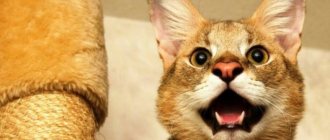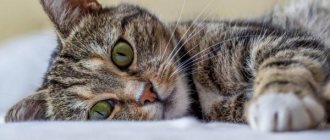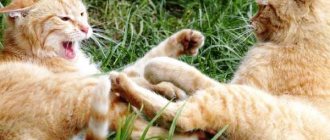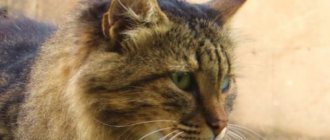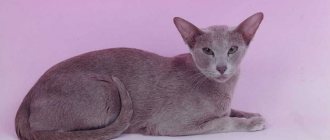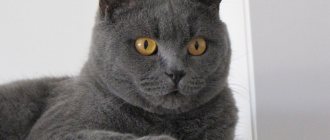The Burmese cat, with its roots in Asia, is considered especially revered in its homeland. This is evidenced by its second name - sacred Burma. The first representatives appeared centuries ago, but received official recognition as an independent breed relatively recently.
The Burmese cat breed is mentioned in a large number of different legends about its origin, and is often mentioned in the mythology of the Asian region. Today, these cats are loved by society and have spread all over the world, thanks to their original, interesting appearance, calm character, and friendliness.
basic information
The sacred Birman cat is of medium size, light weight, and belongs to the long-haired type. Beautiful appearance matches a pleasant character.
| Name | sacred birman cat |
| Country of origin | Burma (Myanmar) |
| Type | long-haired |
| Weight | 4-6 kg |
| Age | 12-18 years old |
| EMS code | SBI |
Estimation of breed characteristics
| Adaptability | ***** |
| Problems with shedding | ** |
| Tenderness | ***** |
| Need for communication | ***** |
| Health | *** |
| Grooming | * |
| Attitude towards children | **** |
| Get along with dogs and other pets | **** |
| Activity | ***** |
| Intellectual abilities | ***** |
Description of the breed
These are not the largest representatives of the cat family. A cat weighs about five to six kilograms, and a female cat weighs up to four. Their life expectancy is quite respectable, they live about fifteen years and longer if the animal is provided with good conditions and proper maintenance. High-quality nutrition, coat and ear care, vaccinations, and hygiene are of great importance. He is famous for his flexible character and his intellectual abilities are quite high.
Story
The official history of the sacred cat breed is quite long. It was first recognized in France about a century ago - in 1925. In 1959, representatives came to the United States, and by 1967 they received recognition from various associations. In the 70s they became known in Europe, Australia and New Zealand. They came to Russia in the 90s.
There is a beautiful legend about the appearance of these cats and their acquisition of sacred status. The cat Singh, who lived at the temple of the Indian goddess - the mistress of souls, stood up to protect the priest who died at the hands of bandits. The intervention did not save the priest, but the goddess appreciated Singh’s courage.
Her long white fur was given a golden hue, and her amber eyes became bright sapphire. The edges of the paws remained boiling white, symbolizing the purity of the deceased monk. These changes affected other temple cats, which surprised the servants who returned to the temple after the attack. The legend explains why it is called “sacred” or “holy”.
According to felinologists, the sacred Burma is a product of crossing Angora cats with Siamese. Like Balinese cats, which have a similar origin, they have a soft, silky coat. It is not known whether the breeding process was planned or accidental, or when exactly the mating occurred. The probable place of origin of the breed is considered to be southeast Asia.
There is a version that European individuals took part in the appearance of this variety; this happened in France. Gordon Russell and Auguste Pavy handed over the blue-eyed offspring to the ministers, expressing their gratitude. Regardless of the story, the result was amazingly beautiful cats with unique personalities. Another famous breed from this region is the Burmese, but it looks completely different, it is a short-haired beauty.
Standard
The requirements for the exterior are quite strict. The main parameters of the breed standard are presented in the table:
| Category | Description |
| Wool | Beige, has a golden hue, silky, soft, medium length, on the muzzle there is a “Siamese” mask, short fur, on the paws there are white “socks”. Around the neck, elongated hairs form a resemblance to a lion's mane, and the undercoat is scanty. |
| Muzzle | Heart-shaped, with high cheekbones, soft features. |
| Eyes | Intense blue color, oval, symmetrically located. |
| Forehead | Slightly rounded. |
| Nose | Medium size, with a slightly rounded tip, in line with the middle of the chin. |
| Ears | They have the shape of an isosceles triangle, medium size, set with a slight bevel, the tips are rounded. |
| Tail | Long, can reach the shoulder, fluffy, shaped like a feather. |
| Paws | White socks are short and equal in length, with a clear pattern. On the front legs they end up to the carpal pad, on the hind legs - up to the hock joint. The socks start from the toes, the pads are pink. |
Disadvantages of appearance:
- short stature;
- excessively long limbs;
- rough, too long or short coat;
- presence of white spots;
- insufficiently contrasting color;
- close-set, small or too light eyes, squint;
- irregular muzzle shape, triangular or round;
- chin slope;
- long or shortened nose;
- ears: long or pointed, standing close together, curved back, folded;
- short tail;
- sharp tip of the tail;
- any asymmetry of the “socks”, their absence or excessive length.
Taken together, the regular features of the Burma saint make her appearance very harmonious and attractive, at the same time sweet and bright. Clear blue eyes add some mystery.
Colors and coat
The coat of the Holy Birman is of medium length, the undercoat is scanty. This makes it easier to care for them and clean the room. The colors of these cats are varied, thanks to developing selection. Several varieties are considered acceptable. Like Balinese cats, these are color-point cats with a diamond-shaped dark mask on the face, which is separated from the ears by patches of light fur.
Appearance of a Burmese cat
The Sacred Birman is a medium-sized cat whose coloring resembles that of its Siamese cousins. Her fur is soft and delicate. Ideally, an individual of this breed has long and silky fur and a color point color. A distinctive feature of the Burmese, one might say, their calling card is their bright blue eyes and white “socks” on their paws.
Fluffy handsome man
These cats are especially loved by those who are delighted with the color of the Siamese, but do not like the latter for their thin structure and wayward behavior. Fans of Himalayan cats also find an outlet in the sacred Burma, but those who do not like the latter for their short and squat body. The Burmese cat is a real find in this regard, it is a kind of middle option, a kind of balance between these two breeds. And as a “bonus”, the owners receive her easy-going character and easy-going personality.
Head
Among the Burmese it is proportional, almost round in shape, wide and expressive. The length is somewhat greater than the width; the forehead, against the background of a rather rounded skull, is distinguished by some convexity.
The muzzle is well developed: wide, rounded, with full and prominent cheeks. She seems to be “hidden” under a dark mask. Cheekbones stick out. The chin is strong and strong.
The nose is of medium length, “Roman”, the transition (TICA) from the forehead to the muzzle is clearly defined (FIFe - without transition).
Eyes
The Burmese cat's eyes are large, expressive, almost round in shape, and set wide apart. Sapphire blue, their color can vary from light blue to dark blue. Dark eye shade is preferable.
Ears
Located on the sides of the head, a slight forward tilt is noticeable. The size is medium, the tips are rounded. They can be placed both moderately and widely. The inner part of the auricle is expressively pubescent.
Neck
The neck of Burmese cats is short to medium length, muscular and wide.
Muzzle of a Burmese cat
Body
Squat, elongated in shape and dense in constitution, with well-developed and strong muscles. The bone structure is powerful. The average weight of an adult Burmese cat is about 6 kg.
Legs and paws
The legs are thick, strong, of medium length, and muscular. With existing color variations, rings may appear on the legs. Large, strong and round paws, with tufts of hair between the toes.
Tail
Fluffy, medium length, uniformly dark color. Fluffy tip. The Burmese usually carries his tail up.
Color
Burmese cat with red markings
Burmese cats are characterized by different variations of color points; these can be gray-blue and dark brown, red and chocolate, cream and lilac. The palette of the rest of the coat can vary from white to cream.
Pigmentation, like in Siamese cats, is allowed only on the face (the so-called “mask”), ears, limbs and tail. Another sign of the Burmese is their white paws, “shod” in “slippers” (or “socks”) - a touch of white, without impurities, color on all four limbs.
The fur on the paws is an impeccable white color and on the front legs it does not rise above the pastern. On the hind legs, the “slippers” end in a sharp “spur.” It is located at a certain distance (1/2 or 1/3) between the hock joints and the large pad of the paw. The color of the pads also varies, the following variations are allowed: pink, dark brown, coffee with milk, pink with dark spots, cinnamon colors.
Burmese kittens are born with an immaculate white color. O begin to appear after 1-2 months. The final coloring is established only in adult individuals. Over the years, the fur darkens.
Possible defects
Eye color that is far from the accepted standard. Silvery shine in one or both eyes, squint. The presence of white or colored spots on the chest and belly, as well as the head, like Persians and Siamese. Non-standard tail structure.
Disqualifying faults
The absence of white “slippers” (“socks”), “spurs” and “gloves” and the presence of white patches on colored areas of the coat.
Knobbiness or curvature of the tail. Excess of the “spurs” of the hock joint.
Spots where they shouldn’t be: colored – on light fur or “gloves”, white – on points. Colored spots on paws.
Character
The sacred Burmese cats inherited the best features from their conditional ancestors, Siamese and Persians. They are both loving and unobtrusive, not as phlegmatic as the Ragdoll, because despite their softness, they have a bright character. The pet loves its owner very much, but has a positive attitude towards all family members, dogs, and other pets.
He loves to sit in his arms, but if he understands that a person is busy, he will not impose himself, unlike the Burmese, which is distinguished by its cheerfulness. Burma will wait for a favorable moment and will stay somewhere nearby. They are not bossy and demanding like Siamese cats, but they have inherited a fairly high level of intelligence. By nature, Burmese are very curious, actively exploring the surrounding space.
What colors are there?
A Burmese cat should have markings on the edges of its body, muzzle, ears, paws, and tail, like those of one of the ancestors of the Siamese cat. However, the Burmese's paws are always white at the end. The color is uniform, regular, contrasting with the entire fur coat. There are several color options for the Burmese breed.
- Point row (color of markings): blue (bright gray with a blue tint); cream (cream); ed (red); lilac (lilac on light gray); seal (brown); chocolate (light chocolate color).
- Tobby color containing stripes.
- Tortoiseshell fur coloring.
If there is white color in the markings, but there is none on the paws, then this is a significant flaw, which leads to the disqualification of the individual from the purebred.
Peculiarities
There are many positive features. Their balanced character plus high intelligence makes them friendly and calm. They don’t remember insults, are easy to train, develop good habits, and are non-aggressive. The almost complete absence of undercoat makes regular grooming easier. Blue-eyed pets do not shed as much as other fluffies. The coat is delicate, silky, and easy to comb, unlike the Neva Masquerade, a long-haired breed with a similar color.
The disadvantages include a number of points:
- Loud noise is annoying, you need a quiet place to rest.
- They resolutely refuse food they don’t like.
- Leaving someone alone is a bad idea and can cause stress.
- Drafts and coolness can cause disease due to the small undercoat.
- The cost is high.
Negative reviews are almost never found. A friendly, handsome guy with a bright appearance lives up to his reputation as a good pet. If a small child causes severe pain, the mustachioed beauty is capable of displaying aggression.
“Many owners note that such kittens are playful and restless. By the age of two or three, they acquire some solidity, their delicacy becomes more obvious. Throughout their lives they maintain a high need for communication and curiosity.”
Maintenance and care
Caring for them is no more difficult than for other long-haired pets. There are procedures that should be performed regularly. If you follow all the rules, the fluffy will be healthy and beautiful. Cannot be kept in cool, ventilated areas. Protective bars on windows are required. It is recommended to brush your teeth and ears every two weeks. The claws are trimmed and trained to use a scratching post. Walking outside is recommended to be done under supervision so that the cat does not get lost.
Grooming
No special grooming is needed. A good salon will find something to offer the owner, but many manage on their own:
- comb long hair every two to three days;
- During shedding, daily brushing is recommended;
- bathe monthly depending on the degree of contamination;
- the use of special shampoos and other hair care products is allowed;
- brush your teeth and ears twice a month or weekly;
- When dirty, the corners of the eyes are cleaned with a cloth soaked in an aqueous solution of vinegar (1:1).
A smooth-haired cat requires almost the same care, in addition to combing. There are special products for cleaning ears and eyes that can be purchased after consulting a veterinarian. Pets accustomed to water from an early age can easily tolerate bathing. To reduce stress, it is recommended not to immerse the animal in a container of water, but to use a hose or shower head.
What to feed
How long a Burmese lives depends directly on their diet. It is allowed to use ready-made food, dry or canned. A diet consisting of natural products must be balanced.
Natural food
Such nutrition completely excludes the use of dishes prepared for people. Salt and any spices are not allowed. Meat makes up 70% of the total diet. The daily norm for an adult is about 200 g. All products must be fresh and of high quality. You can give:
- chicken, rabbit, beef, turkey and other lean meat, which is frozen, treated with boiling water, and then boiled or given raw;
- boiled sea fish, from which the bones have been removed (twice a week or less);
- boiled vegetables mixed with meat, cereals;
- boiled or raw eggs (twice a week);
- green grass (sold in pet stores).
Smoked meats, sweets, fried and fatty foods are strictly prohibited. Adults are not given milk.
Ready food
Dry or canned food must be of exceptional quality, Premium, Super Premium level. Inexpensive food contains additives that can cause an allergic reaction and negatively affect health. This affects the condition of the coat, the functioning of internal organs, metabolism, and the endocrine system.
Experienced breeders recommend using products from trusted brands:
- Royal Canin;
- Orijen,Hill's;
- Akana;
- Felidae
These are balanced formulations containing essential nutrients, microelements, and vitamins. When using dry formulas regularly, you should provide free access to clean, fresh water with a low content of mineral salts. As a reward, you can offer canned food, low-fat boiled fish, fermented milk products, and some shrimp.
Features of feeding
An undoubted positive feature is the ability to control the feeling of satiety. The food can be left freely, there is no danger of overeating, and obesity is excluded. You cannot use low-quality food, such as Whiskas or KiteKat. There are a lot of useless, cheap ingredients, flavorings that cause urolithiasis, gastrointestinal problems, dermatitis, and other serious diseases.
The money saved on food will have to be used to pay for veterinarian services. It is not always possible to regain lost health. Despite their sweet nature and commendable self-control while eating, they are picky in this area. If the animal in the nursery has already been accustomed to a certain type of food, it is recommended to continue feeding it with products of that particular brand.
Diet
If you don’t have free time, the best option for your pet’s menu would be premium food, for example, Hill’s, Royal Canin or Felidae. This mixture contains the necessary amount of nutrients and vitamin and mineral supplements. Since Burmese are not prone to overeating, uncontrolled appetite and obesity, you can leave food freely available to them without worrying that the cat will feel ill. High-quality dry food promotes mechanical cleaning of teeth, so it is also an excellent prevention of dental diseases in cats.
If the owner has enough time, the Burmese can be fed natural food. The optimal number of feedings is 3-4 times a day. However, cat food is not sweetened, salted or seasoned. It is forbidden to give your pets potatoes, onions, or bread. Milk and fish can be included in the diet in minimal quantities. The basis of the Burmese cat's menu should be:
- lean meat (poultry, beef, rabbit);
- offal (cleaned stomachs, hearts, broken necks);
- some cereals (well-cooked buckwheat, oatmeal, rice in a 2:3 ratio with meat);
- low-fat fermented milk products (cottage cheese, kefir, yogurt without additives);
- quail eggs, chicken yolks;
- some boiled vegetables;
- vitamin supplements (Hartz, Beaphar, Canina)
Health and illness
A purebred individual without health problems is a rare case. Sacred Burma has its weak points. Here is a list of diseases to which they are predisposed:
- Congenital hypertrophy - manifests itself in the appearance of baldness, causes immunodeficiency, and ends in death.
- Corneal dermoid, in which a thin layer of skin or hair forms on one or both eyes, is corrected surgically.
- Spongiform degeneration is a disease of the central nervous system, manifested by problems with coordination, weakness of the limbs, and causes complete or partial paralysis.
- Body trembling is a problem typical for newborn kittens in the first ten days of life, disappears by the age of three months, the cause of the symptoms has not been established.
- Elevated creatine levels are a common problem in individuals with kidney disease.
- Hypertrophic cardiomyopathy, expressed in increased drowsiness, shortness of breath, occurs rarely.
A hereditary Burmese disease is corneal dermoids. A course of antibiotics and special drops prescribed by a veterinarian solves the problem. Veterinarians note that serious problems arise under the influence of genetic factors. Proper care prevents illness. To avoid periodontal disease, brush your teeth regularly.
“Regular ear care does not protect against otodectosis caused by mites. It is necessary to monitor behavior, especially after being outside. If there are dark scales in the sink, the cat shakes its head, and itches frequently, it’s time to go to the clinic.”
An important point is timely vaccination. Vaccinated from:
- depriving;
- rabies;
- plague;
- panleukopenia;
- chlamydia;
- viral leukemia;
- rhinotracheitis.
The schedule is agreed upon with the veterinarian, vaccination begins at approximately four to five months of age, sometimes closer to one year of age. Over time, revaccination will be required. It is necessary to sterilize cats that are not intended for breeding to avoid complications caused by “empty” heats.
“The owner should note changes in condition and contact a veterinarian immediately. Early diagnosis allows you to quickly deal with the problem. With a balanced character, changes in behavior will become immediately obvious.”
Coat and color
The fur coat of the Burmese is shiny, silky, without undercoat. The hair is longer on the back, tail and collar, and slightly shorter on the legs and belly. The colors of the animal vary in a wide range of colors; the following colors are typical for the breed:
- lilac;
- beige;
- chocolate;
- blue;
- red;
- tortoiseshell;
- acromelanic (with darker tail, paws, ears, muzzle).
On the hind legs of the Burmese there are white gloves, which are limited to the wrist joint; on the hind legs there are “boots” with L-shaped spurs in the lower part. In pedigree cats, breeders strive to maintain symmetrical white spots on the paws. The original color of the fur coat of the Burmese appears with age, and newborn babies have a pure white fur color. Over time, they develop color points, and at 3 months of age, snow-white markings on their paws become noticeable. The color becomes saturated at 1.5 years.
Pregnancy and childbirth
It is recommended to breed cats every 8-10 months, not more often, so that the body has time to recover, which increases the possibility of getting healthy offspring. The optimal time for the first pregnancy is at one year of age or a little later, when the female can safely bear healthy and strong kittens.
The onset of pregnancy after mating is indicated by obvious signs:
- behavior changes;
- vomiting appears;
- appetite increases.
They appear about three weeks after mating. If a delicate beauty suddenly becomes irritable and avoids communication, kittens will probably appear after about 65 days. The owner’s task is to provide proper nutrition, conditions for childbirth and care for the offspring.
Food should contain an increased dose of proteins, vitamins and essential microelements. Before giving birth, anxiety will increase, the expectant mother will begin to look for a secluded and comfortable place. A fairly spacious box with soft bedding made from natural materials is ideal. Complications during childbirth are rare, although you should not leave the animal alone. In due time, 4-6 kittens appear.
Kittens
Snow-white, clumsy newborn lumps bear little resemblance to their mother, but by the age of one month the color begins to gradually appear. At three months the socks will become visible. At one year of age, the color will be more clearly visible; by two years it is almost formed, but the final characteristics of the “color” will be fixed closer to three years.
The eyes are bright blue at first and then lighten, this is a natural process. As they mature, by eight months they will have a distinctive blue color. Kittens are taken from the nursery at two or three months.
“If a breeder offers an older specimen, it makes sense to consider the offer. The quality of such individuals can be quite high, since they have been under professional supervision longer, received qualified care, and often have experience participating in exhibitions.”
The nursery sells pets that are fully prepared for independent living. They are vaccinated, dewormed, trained to a tray and food. Along with the pet, the new owner is given a small amount of his favorite food and a portion of litter from the toilet. They are needed to facilitate adaptation to a new place.
Before buying a kitten, you should choose a place for the toilet (private but accessible, it should not be locked) and for feeding (not too far from the toilet, in a quiet place). There is no need to let the new family member out of the carrier right away. First you need to transfer the feed and filler received from the nursery into containers.
Now the kitten is taken out of the carrier and placed in the toilet. You should wait patiently for the newcomer to get out of it on his own. The new family member is then taken to the food bowls and left alone to allow them to explore the new area on their own.
A big mistake would be trying to pet and cuddle your pet on the first day. This will increase stress and may result in a nervous and unsociable under-the-couch pet. Burmese are generally intelligent and calm, but it is not worth risking their mental health.
There is no special food for such kittens. A good choice is holistic food of the Premium or Super Premium class, designed for a certain age. 100-150 g of feed per day is more than enough.
Upbringing
Raising them is not difficult, they are smart and willingly follow established rules. They are trained to use the tray in the nursery, and there are no problems in this regard. An important point is adherence to the established regime. Deviation from the accepted order will cause discomfort in a disciplined beauty; frequent and sudden changes lead to the development of a stressful state.
For the sake of your pet’s health and the integrity of the furniture, you need to install a scratching post in advance to teach him to use this device. Having settled into their new home, kittens quickly get used to sleeping in the designated place. Independent walks in the fresh air are contraindicated. There is a high risk of injury, contracting parasites, and contracting a disease.
“Some owners have successfully trained their pets to use the toilet. Then the clean little one persistently follows the owner, demanding to wash off the excrement.”
Mating and breeding
Burmese are bred only with Burmese - this is an immutable rule of all breeders. Specialists carefully select parental pairs to consolidate and develop the characteristics of the breed. No one can guarantee the receipt of kittens with ideal characteristics. Most often, problems arise with white socks. Excessive length and asymmetry immediately become a reason for removing an individual from breeding work and transferring it to the “pet” class. How much a Burmese beauty kitten costs depends on the class.
But exterior flaws do not impair character and intellectual abilities. Pets are relatively inexpensive, usually very healthy pets that deserve the title of friendly family member. The rules regarding mating are very strict. Not allowed:
- mating with representatives of other breeds or with individuals without pedigree;
- with pets who, despite having a pedigree, do not have the right to breed;
- mating more than three times over two years;
- searching for mating partners randomly, for example, on the Internet;
- organizing electronic auctions for the sale of mating services.
For cats, the break between matings should be at least two months. Each mating is documented by the relevant club documents with the signatures of the owners and co-owners. Walking on the street is prohibited. Animals should not be left locked alone for long periods of time. The recommended area for the sacred Burma to live is from six square meters. The premises must be protected from strong drafts and bad weather and be fully accessible to the owners.
It is better to entrust the selection of a parent pair to geneticists who are constantly working to improve the breed's gene pool. A few months before the “date” they begin preparing the pets: examination, deworming, vaccinations, etc. It is considered normal practice to require a certificate from a veterinarian confirming the health status of the future partner.
These precautions increase the chances of getting not only beautiful, but also healthy offspring. The breed is rare, and felinologists’ concern for the purity of the offspring borders on fanaticism. Mating with a random partner “for the sake of health” in felinological circles is considered almost a crime.
“Breeders note that breeding the sacred Burma does not bring much profit. This business requires a lot of time, high costs and dedication, since it is impossible to predict the result of the mating, whether it will be an ordinary pet or an expensive specimen for show. There are other breeds for earning money. Burma is bred for the soul.”
Burmese cat: blue-eyed stealer of women's hearts
It is human nature to invent. With great pleasure, he is ready to complete what nature itself has not completed or even invented. This is how decorative breeds of dogs and cats appear. The origin of some breeds is difficult to recognize - only a professional can discern what “parts” enthusiastic breeders used. But in some cases, even an amateur can cope with this task - for example, look at the video of a Burmese cat. Who do you think her ancestors were?
Video: @joy.sbc
Let's not test the patience of those who doubt it - the Burmese cat was created by crossing two breeds: the Persian and the Siamese cat. From the first she borrowed a long, luxurious coat, and from the second - a characteristic color. The legendary place of origin of this amazing animal is considered to be Burma, a state on the territory of the former Indochina, which today is called Myanmar. This is where the original English name of the breed comes from - Sacred Burma. Wherever the Burmese cat was born, it has been known in Europe since the beginning of the 20th century, where the first individuals were brought by the Vanderbilt family of American billionaires. In 1925, the breed was first recognized and registered in the French Cat Register, and, since then, began its triumphant spread throughout the world. As you probably already guessed, our guest today is a Burmese cat, who will be introduced by her owner Valentina @joy.sbc .
Photo: @joy.sbc
Photo: @joy.sbc
- Hello, Valentina! Will you introduce us to your pet?
- Hello! This is Joy, a cat of the Sacred Burma breed. Joy is one year and two months old.
- Oh, yes, he is still very young! I believe that the impressions of your first acquaintance are still fresh. Tell us why you chose this particular breed, or did Joy come into your family by chance?
“It was a completely conscious choice, and my mother’s choice at that.” Essentially, Joy is her cat, but since we now live together, this pet has two caring owners at once. Mom wanted this breed for a long time - she dreamed of a Burmese cat twenty years ago. We first learned about it from the encyclopedia. We studied the characteristics of this breed in great detail, so the issue with the establishment was purely technical - alas, the waiting time lasted for years. But such an opportunity arose, and we began to search for a Burmese kitten in all seriousness.
Photo: @joy.sbc
- Where did you find him?
— In one of the nurseries in St. Petersburg. We ourselves live in Moscow, so we had to go to another city to pick up Joy. However, the efforts were worth it, because this particular kitten had the color we wanted. I went to St. Petersburg on a Sapsan one weekend. On the way home, Joy sometimes meowed - he probably missed his mother. But, despite the melancholy, he showed amazing curiosity, constantly looking around and sniffing. And when we crossed the threshold of his new home, the kitten settled in surprisingly quickly. Already on the second day he felt like the rightful owner of this place.
Photo: @joy.sbc
Photo: @joy.sbc
Compare
Close
House "Whale" (sisal)
1 746,85 ₽
The Kit House (sisal) is a scratching post for your pets. This is two in one: a useful nail sharpener and a cozy
Add to cart
Quick view
Compare
Close
House-scratching post “Mouse” (sisal)
1 937,75 ₽
House-scratching post “Mouse” (sisal) ChipSetConfident PC user
Add to cart
Quick view
Compare
Close
House "Oval Office" with three scratching posts (sisal)
2 872,70 ₽
House "Oval Office" with three scratching posts Fur house-scratching post "Oval Office" with three scratching posts - a very convenient thing! In such a scratching post house
Add to cart
Quick view
To order
Compare
Close
Square house with scratching post (sisal)
0,00 ₽
Square house with scratching post (sisal) Square house upholstered in faux fur with scratching post and lounger ChipSetConfident PC user
More details
Quick view
- Great. You've already mentioned Joy's curiosity. What other features of your pet can you highlight?
- Let me think... Probably intelligence, cunning and willfulness. But this is not a cold and calculating creature - Joy is incredibly friendly and loves communicating with people. In a conversation with us, he can meow in response, expressing his feline position not only with gestures, but also with his voice. He behaves in the same way with guests, even if they are complete strangers to him. But Joy undoubtedly leaves most of her warmth and affection for us. He loves to fall at his feet - sometimes he lies down right on his feet. As if hinting: “You, mistress, mind your own business, and I will calm you down and support you.” My return home is always a holiday for Joy, he always greets me. Like any cat, he loves to sleep. He is engaged in “indoor mountaineering” - he can open the right closet door in a jump! But he doesn’t ruin the furniture or decor—believe it or not, he uses all the cat equipment we bought for him. I know that for some owners this is a problem - their animals are very capricious and choose for themselves what to sharpen their claws on and where to sleep. This was never a question with Joy.
Photo: @joy.sbc
Compare
Close
AROMADOG Dog toy BIG HEAD Bear 12 cm blue
364,72 ₽
Owners sometimes don’t even understand that their pets’ irrepressible desire to spoil personal belongings and furniture is a kind of request for the purchase of new fun.
Add to cart
Quick view
Compare
Close
AROMADOG Dog toy BIG HEAD Dog 12 cm lilac
364,72 ₽
Owners sometimes don’t even understand that their pets’ irrepressible desire to spoil personal belongings and furniture is a kind of request for the purchase of new fun.
Add to cart
Quick view
Photo: @joy.sbc
- Very comfortable cat! I can say this from my own experience, because my cat has exactly this problem. )) Let's go through the content a little. I believe that the main difficulty in the Burmese cat, like in its Persian ancestor, is the fur?
— This is rather not a difficulty, but an honorable duty. We brush Joey often, almost every day, sometimes every other day. This is very important not only for beauty, but also for the health of the animal, so that excess hair does not get into its stomach. Every year we took Joey for a super-shedding procedure, after which we brushed the pet much less often - about once a week. Brushing the fur is the main task that the Burmese cat finds difficult to cope with on its own. Otherwise, Joy himself is an exceptional neat person and never neglects the rules of personal hygiene. The only other thing we help him with is washing his paws after walks in the country, when soil accumulates between the pads and on the claws.
Photo: @joy.sbc
— It turns out that the Burmese cat is no more difficult to care for than any other long-haired breed. What can you say about Joy's diet? Do you prefer industrial food or do you prefer “natural” food?
“We feed Joy with high-quality industrial food, which in its composition is not much different from “natural” food, and in terms of the set of nutrients it is even healthier. Our diet is based on Grandorf dry food - at first we tried various lines, but now, for obvious reasons, we use food for sterilized cats.
Our information: Grandorf food is produced in Belgium at the United Petfood Producers NV plant, and wet food is produced in Italy at the MONGE & C. SpA plant. The official website is https://grandorf.ru/, there is information important for consumers (compositions, recommended feeding rates, etc.). This food is suitable for holistic people.
Compare
Close
1ST CHOICE Active or Finicky dry cat food Chicken
3 335,33 ₽
1ST CHOICE Active or Finicky dry food for cats Chicken 5.44 kg Chicken is the main New component in this nutritionally balanced and very acceptable
Add to cart
Quick view
Compare
Close
1ST CHOICE NF dry food for puppies for skin and wool Lamb/fish/rice
813,90 ₽
1ST CHOICE NF dry food for puppies with skin and wool Lamb/fish/rice 2.72 kg*4 CONTAINER AS A GIFT!!! Dry Puppy Food for skin and
Add to cart
Quick view
To order
Compare
Close
“8 in 1” 109464 Excel Mobile Flex plus 150 g powder (analogous to GLUCOSAMINE - prevention of joint diseases in dogs)
1 164,41 ₽
Product description “8 in 1” Excel Mobile Flex plus 150 g powder (analogous to GLUCOSAMINE - prevention of joint diseases in dogs) Complex supplement for
More details
Quick view
To order
Compare
Close
“8 in 1” 64232 Shampoo/conditioner for dogs Tinted (light coat) 947ml NEW
537,15 ₽
Product description “8 in 1” Shampoo/conditioner for dogs Tinted (light-haired) 947ml The shampoo is made specifically to enhance the natural brightness of the color of dogs with
More details
Quick view
We also dilute Joy's menu with wet food - these can be products from the same Grandorf, or Schesir. Surprisingly, our boy does not like chicken at all, and the meat itself. It gets to the point where he eats the jelly and broth, but leaves the pieces of food untouched! As a child, we fed Joey at specific times and exclusively with wet food. Due to this, he developed a special habit - if someone goes towards the kitchen at the appointed time, the cat is already waiting for him there, even if he was just sleeping peacefully in another room.
Video: @joy.sbc
- Lunch is on schedule - how could it be otherwise?! )) Tell us more about Joey, what moments with him do you remember most vividly?
— It’s difficult for me to immediately remember a specific episode, because Joy is our first pet, and every day next to him seems especially bright.
I remember one day I decided to try cat food. I opened a can of wet food, and inside was, of course, canned tuna! Well, I couldn’t resist, and now I’m completely calm about Joey’s diet. This is a truly high-quality and tasty product, even from a human point of view.
Once Joy mastered the wisdom of “indoor acrobatics” and tested the strength of a cornice with curtains. The result, as one might assume, was appropriate - the cornice, the curtains, and behind them the cat itself, flew to the floor with a roar. On the other hand, a negative experience is also an experience; Joy did not attempt any more attempts on the cornices.
And one day Joy found a real mouse! But you understand - this is a domestic cat, for whom a small animal is not food, but decorative entertainment. Luckily for us, because we don’t know what’s in these wild mice... We had to call a pest control specialist to calm our nerves.
Well, I remembered another incident. Once we went out to the dacha with my friend. I took Joy with me, and she took her dog Clyde @clyde.msk. Clyde happily accepted his new play partner, but my cat was somewhat taken aback by the size of such a giant and perceived him as an obvious threat - he hissed, raised his fur and walked around him. However, the friendly disposition and complete lack of aggression on the part of the dog replaced anger with mercy - Joey began to cautiously approach Clyde and even met him nose to nose a couple of times, sniffing. I believe that if our vacation lasted two weeks, the cat and dog would turn into best friends!
Photo: @joy.sbc
— Is Joy the only pet in your family?
— Right now, yes, but my mother and I are planning to have another one. She wants another Burmese cat, and I'm thinking about adopting an animal from a shelter. Therefore, we have not reached an agreement yet.
- Well, I wish you to find a common language and add another tailed friend to your family. Valentina, Joy, thank you for the interesting conversation! And in conclusion, we usually invite our guest to address the readers directly.
- Friends! We wish you to have animals, devoting your precious time and attention to them from the heart. Don't skimp on care and food. An animal always needs your support, even if at first glance it seems independent and unsociable. He may need even more care than a loving and sociable one! Choose a breed that suits you and for yourself - this is especially important! And if you don’t have time for a pet, it’s better to give up this idea altogether, it will be better for both him and you.
Adopt cats and dogs from shelters or even straight from the street! They, unlike purebred individuals, most likely will not have another chance to find a family. And if you encounter difficulties in rehabilitating and raising such animals, you can always turn to professionals. For example, to people like @cats_from_shelter
— I and our editors completely agree with your words!
View this post on Instagram
Posted by Sweet Pie Joy
